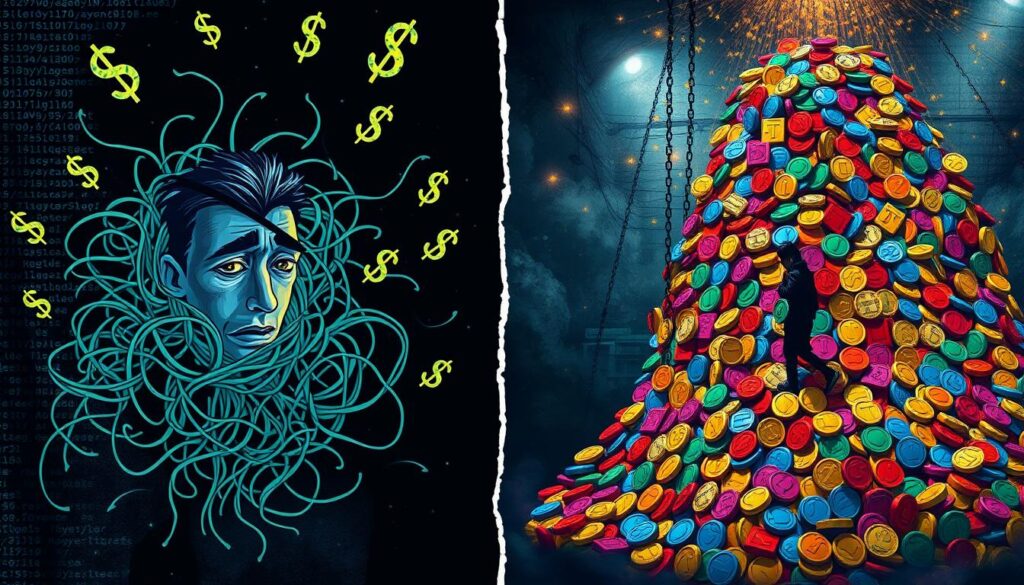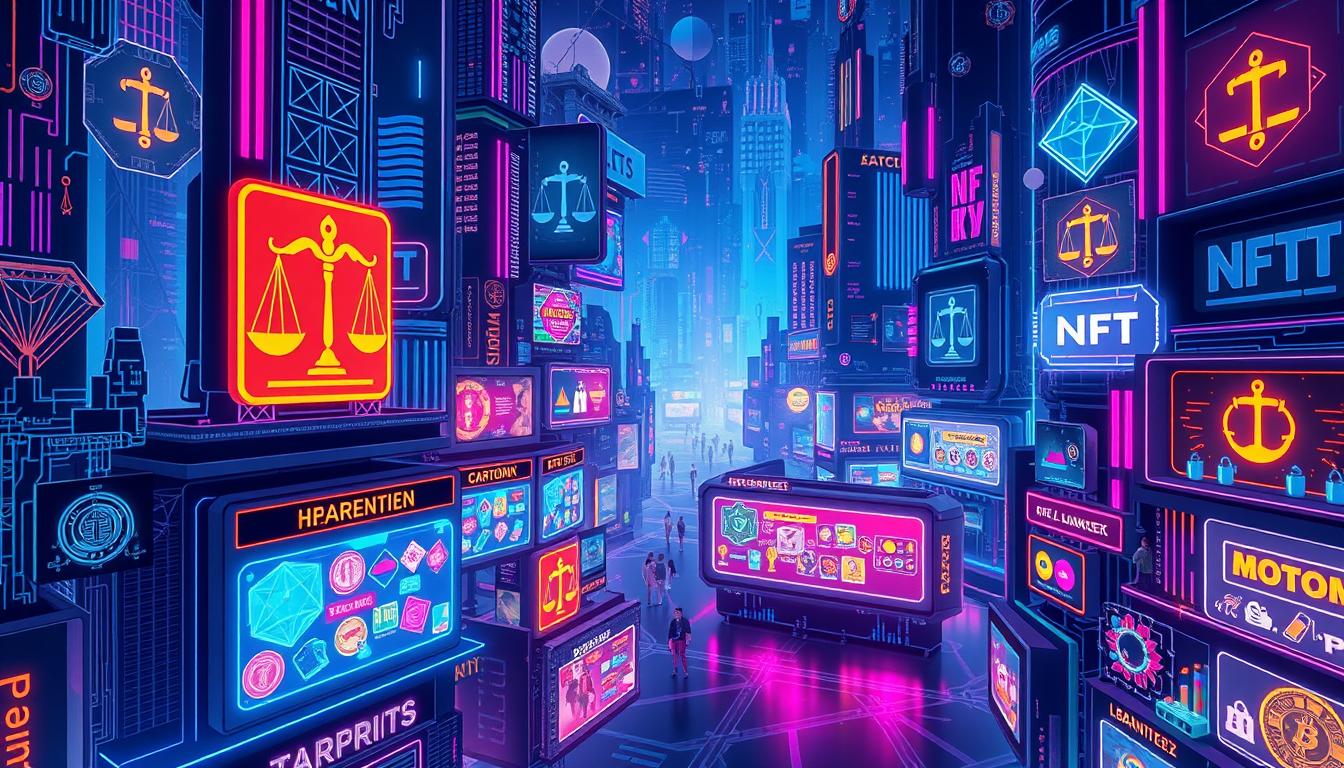The Rise of NFTs: Legal Challenges and Opportunities
Did you know that in just one month, over $208 million in NFTs related to artwork were sold? This staggering figure represents a dramatic increase in the world of digital ownership, especially when you consider that the total NFT volume traded for the entire previous year was only $250 million. As the market for Non-Fungible Tokens continues to expand, highlighted by remarkable sales like Beeple’s NFT collage that fetched $69 million, you can see the transformative potential of NFTs within the digital art space.
However, along with the immense opportunities offered by NFTs come significant legal challenges. This evolution in how art is created and monetized gives rise to complex issues surrounding intellectual property rights and data protection. As this technology develops, understanding the legal landscape will be crucial for both creators and consumers navigating the nuances that come with owning and trading unique digital assets.
Key Takeaways
- The NFT market skyrocketed to over $208 million in one month, signaling a rapid expansion.
- Beeple’s successful sale of an NFT for $69 million marks a significant milestone in digital art.
- Legal challenges around intellectual property rights are becoming more pressing as NFTs gain traction.
- Creators can set resale prices and control how many replicas of their work exist.
- The ever-evolving NFT landscape requires ongoing awareness of regulatory developments.
Introduction to NFTs
Non-Fungible Tokens, or NFTs, represent a transformative development in the landscape of digital ownership. This shift harnesses the power of blockchain technology, allowing you to own unique digital assets with verified authenticity. Unlike traditional cryptocurrencies such as Bitcoin, which are interchangeable, NFTs are distinct and cannot be exchanged one-for-one. This unique characteristic provides a new avenue for creators to monetize their digital creations effectively.
NFTs have made significant waves in the art world, evidenced by high-profile sales fetching millions of dollars at auction. Their popularity illustrates a growing trend where artists and creators are embracing this technology to establish ownership of their work securely. Blockchain serves as the backbone of this system, ensuring that ownership records remain immutable, which means they cannot be altered or duplicated. This transparency fosters confidence among investors and collectors in the burgeoning market.
Typically purchased using cryptocurrency, NFTs democratize ownership, allowing more individuals to invest in digital assets that were once only accessible to a select few. Creatives now have the potential not only to increase the value of their works but also to tap into various industries well beyond art, including gaming, real estate, and finance. The unique selling propositions of NFTs, such as smart contract capabilities and global accessibility, position them as revolutionary tools in this digital age.
The rise of this technology introduces endless possibilities for securing and verifying ownership across various sectors, ultimately reshaping traditional concepts of ownership. As blockchain technology evolves, NFTs will likely continue to influence how digital assets are perceived, valued, and traded.
| Aspect | Description |
|---|---|
| What are NFTs? | Digital certificates of ownership that are unique and non-interchangeable. |
| Ownership | Established through blockchain technology, ensuring verified authenticity. |
| Currency Used | Primarily purchased using cryptocurrency. |
| Market Impact | Significant sales in art, collectibles, real estate, and gaming. |
| Potential Challenges | Environmental concerns, regulatory uncertainties, and market volatility. |
| Future Opportunities | Revolutionizing ownership in various industries and enhancing investment diversity. |
The Rise of NFTs in Digital Art
The emergence of NFTs has transformed traditional notions of ownership in the art sector. Digital artists can now sell their creations directly to consumers, bypassing the limitations of conventional galleries or auction houses.
The financial implications are vast, evidenced by sales that reach millions of dollars. This shift indicates a robust market value associated with digital art collectibles, inviting not only artists but also investors and collectors to engage in this dynamic space.
- Global Reach: NFTs offer artists access to international markets, enabling them to connect with audiences far removed from their locales.
- New Revenue Streams: Artists can monetize their work effectively, establishing a direct relationship with buyers while ensuring ongoing royalties through smart contracts.
- Democratization of Art: Diverse creators now find opportunities for recognition and financial success, varying significantly from previous artistic paradigms.
Despite the opportunities, challenges surround the NFT ecosystem. Environmental concerns arise from the energy-intensive processes of blockchain technology used for minting and trading these tokens. Advocates for sustainable practices emphasize the need for solutions that mitigate ecological impacts while maintaining the integrity of the digital art market.
In response to the changing landscape, platforms such as OpenSea and Rarible have emerged, creating virtual galleries where artists can showcase and sell their works. This proliferation highlights the growing adoption of NFTs, enhancing the visibility of digital art and solidifying its place in modern culture.
| Aspect | Impact |
|---|---|
| NFTs in Digital Art | Facilitating direct sales, bypassing traditional systems |
| Market Value | High-value sales demonstrating financial effects |
| Global Accessibility | Breaking geographical barriers in art consumption |
| Environmental Concerns | Energy consumption and the search for sustainability |
| Smart Contracts | Automating royalty payments for verification |
This whirlwind evolution in the digital art space continues to invite debate on both ethical and ecological fronts, ensuring that the conversation about NFTs remains vibrant and relevant. As you navigate this exciting domain, an understanding of both the opportunities and challenges will enhance your engagement with the growing phenomenon.
Understanding Non-Fungible Tokens
Understanding Non-Fungible Tokens (NFTs) involves recognizing their unique characteristics and the technology behind them. NFTs are distinguished from traditional cryptocurrencies due to their non-fungibility, meaning each token is unique and cannot be exchanged on a one-to-one basis. This uniqueness is what makes them ideal for representing digital assets such as art, music, and collectibles.

NFTs leverage smart contracts on blockchain networks, which serve as automated agreements that outline the specifics of ownership and transfer. The transparent nature of blockchain helps ensure that ownership records are immutable and publicly verifiable, thereby enhancing trust among buyers and sellers.
Some notable examples highlight the rising importance of NFTs. In early March 2021, digital artist Beeple made headlines when one of his works sold for an astounding $69 million. This marked a turning point in the recognition of digital art and its value. Platforms like OpenSea showcase an array of categories, facilitating the trading of NFTs across different digital asset types, including virtual worlds and trading cards.
The ERC-721 and ERC-1155 standards play significant roles in how NFTs are created and traded. While ERC-721 supports single token creation, ERC-1155 allows for batch processing, which reduces transaction costs and increases efficiency. These standards exemplify the innovation occurring on the blockchain and within the NFT space.
Furthermore, NFTs have opened new avenues for industries such as real estate, where properties can be tokenized. This enables fractional ownership, allowing multiple investors to hold shares in a property, thus enhancing market liquidity. Such innovations redefine asset management using the principles of smart contracts.
While the potential for NFTs continues to expand, challenges concerning intellectual property rights, ownership validation, and concerns about marketplace scams persist. Ensuring that users understand these dynamics will be crucial as NFTs continue to evolve within the digital economy.
Blockchain Technology and Its Role in NFTs
Blockchain Technology acts as the fundamental framework supporting NFTs, offering a transformative approach to digital ownership. This technology enables the creation of unique and verifiable tokens, setting NFTs apart from interchangeable cryptocurrencies. Through the use of smart contracts, each transaction involving NFTs is governed by automated terms, ensuring transparent and secure exchanges.
The immutable records maintained on the blockchain enhance the security and reliability of NFT transactions. By decentralizing data storage, this technology protects against counterfeiting and fosters trust among users. Each NFT’s authenticity is easily verified, an essential aspect of maintaining exclusivity in the digital marketplace.
The convergence of NFTs and Web3.0 exemplifies a shift toward decentralization and user empowerment, igniting a vibrant space for digital art and collectibles. As various industries embrace this technology—ranging from arts and entertainment to finance and real estate—NFTs are redefining what constitutes digital ownership. They serve not only as proof of ownership but also as a means to monetize creativity and fan engagement.
ChainCode Consulting LLP is at the forefront of these advancements, proposing innovative solutions like NFTtrace that utilize dynamic NFTs to ensure transparency and track asset provenance. Such applications illustrate how blockchain technology acts as a catalyst for revolutionizing asset management, enhancing operational efficiency across numerous sectors.
With an impressive record high NFT sale reaching $91.8 million, the market has showcased immense potential despite experiencing fluctuations. This dynamic landscape highlights the enduring interest of high-value brands, such as the Premier League and Louis Vuitton, as they move toward integrating NFTs into their offerings. The adaptability of NFTs demonstrates their capacity to influence various industries, emphasizing the lasting impact of Blockchain Technology on digital ownership.
Legal Landscape Surrounding NFTs
The legal framework concerning NFTs creates a distinctive environment, fraught with complexities. As this sector evolves, it is essential to navigate aspects such as intellectual property rights, data protection, and various regulatory considerations. Understanding these elements is crucial for creators and consumers alike in the burgeoning NFT marketplace.
Intellectual Property Rights and NFTs
Your engagement with NFTs necessitates a clear grasp of intellectual property rights. Owning an NFT does not automatically confer ownership of the intellectual property associated with the underlying asset. Many creators retain these rights even after transferring an NFT, leading to potential misunderstandings for buyers. Producers must assert their rights before minting to avert legal repercussions stemming from copyright infringements. With the rise of cases involving manipulated valuations, such as those involving collections like Bored Ape Yacht Club, a commitment to transparency becomes paramount.
Data Protection and Privacy Issues
The immutable nature of blockchain technology poses challenges regarding data protection laws. As NFTs often link to assets stored off-chain, concerns arise about how personal information is managed and secured. Regulatory frameworks, such as the Anti-Money Laundering Act of 2020 and guidelines from the Financial Crimes Enforcement Network, impose obligations on platforms to ensure compliance with data protection standards. NFT marketplaces must navigate these regulations while ensuring the rights of consumers are respected, particularly concerning privacy and the ability to modify or delete personal data.
| Legal Aspect | Considerations |
|---|---|
| Intellectual Property Rights | Ownership does not include underlying asset rights; verify rights before minting |
| Consumer Rights | Importance of transparency in ownership and value |
| Data Protection | Challenges related to personal data management on blockchain |
| Regulatory Compliance | Adhering to anti-money laundering regulations and KYC procedures |
As the NFT market continues to expand, the need for clear guidelines on intellectual property rights and effective data protection measures is evident. The lack of clarity poses risks for all participants, emphasizing the importance of understanding the legal landscape surrounding NFTs.
The Rise of NFTs: Challenges for Creators and Consumers
The evolution of NFTs has introduced various challenges for creators and consumers alike. As the market has expanded rapidly, issues surrounding ownership concerns and the enforcement of rights have become increasingly prominent. You may encounter situations where purchasing an NFT does not equate to owning the underlying artwork or content, leading to confusion and potential disputes.
Ownership and Authenticity Concerns
Ownership concerns are critical as many NFT creators retain specific rights, which may not be clear at the time of purchase. This ambiguity can lead to misunderstandings regarding what you genuinely acquire. Verification of authenticity becomes paramount in a market that has seen a staggering influx of assets, particularly as the reputational landscape can shift dramatically. The rise of counterfeit or plagiarized items emphasizes the need for robust mechanisms to ensure authenticity and establish legitimate ownership.
Royalty Payments and Resale Regulations
Royalty payments form a crucial aspect of sustaining creators’ income, especially during secondary sales. The integration of smart contracts on the blockchain aims to automate these payments, but resale regulations vary widely across different platforms. This inconsistency poses challenges in securing revenue streams from the resale of NFTs, often leaving creators vulnerable. Many find that enforceability of these payment structures is often contingent upon the platforms they utilize, complicating the landscape further.

| Challenge | Description | Impact |
|---|---|---|
| Ownership Concerns | Misunderstanding of rights associated with NFT purchases. | Leads to legal disputes and consumer dissatisfaction. |
| Authenticity Verification | Difficulty in confirming genuine ownership amidst rising fakes. | Affects trust in the NFT market. |
| Royalty Payments | Automation via smart contracts is not universally enforceable. | Creators may miss out on earnings from resales. |
| Resale Regulations | Varying rules across platforms complicate revenue streams. | Creates confusion among creators and consumers. |
Opportunities for Creatives and Brands
The emergence of NFTs has unlocked remarkable opportunities for creatives and brands. You can now explore the potential of Monetizing Digital Assets by creating unique digital experiences and collectibles. This trend not only allows artists and creators to generate new revenue streams but also redefines the relationship between ownership and creativity in the digital realm.
Monetizing Digital Assets
NFTs enable artists and creators to monetize their work distinctively. For instance, the sale of Beeple’s digital artwork “Everydays: The First 5000 Days” for over $69 million at Christie’s auction house exemplifies the new financial possibilities arising from NFTs. Similarly, Jack Dorsey’s NFT of his first tweet fetched approximately $AUD3.8 million, illustrating how digital assets can attain significant value. As the landscape evolves, creators across various disciplines are discovering lucrative avenues to monetize their talents.
Brand Engagement in the Metaverse
Engagement in the Metaverse offers brands innovative ways to connect with consumers and introduce unique digital products. By investing in NFT-based items, brands can create immersive experiences that resonate, particularly with younger audiences. For instance, Gucci’s launch of virtual sneakers for $12 and DressX’s offerings of digital fashion products priced between $40 to $250 are effective examples of this trend. These efforts not only enhance Brand Engagement but also align with the growing consumer interest in integrating physical and digital realms.
As businesses embrace the value of NFTs, they can incorporate exclusive access features, offering additional benefits to their customers. Such strategies not only diversify revenue streams but also foster sustainable growth within the evolving digital landscape. To stay informed on legal and ethical considerations related to these emerging technologies, explore the regulations surrounding neurotechnology laws and personal data privacy.
| Benefit | Description |
|---|---|
| New Revenue Streams | Creators can generate income by selling digital assets directly to consumers. |
| Enhanced Ownership Models | NFTs redefine copyright and ownership dynamics, allowing creators to retain rights. |
| Collaborative Opportunities | Blockchain technology encourages collaborations between artists across various fields. |
| Exclusive Consumer Experiences | Brands enhance customer engagement through unique NFT offerings and immersive environments. |
| Royalties on Resales | NFTs allow creators to earn royalties on future sales of their digital artwork. |
Market Trends and the Future of NFTs
The NFT market has experienced significant fluctuations, marked by peaks and deep descents. In January 2022, trading volumes reached an astonishing $17 billion. By September of the same year, this figure saw a dramatic 97% decline. Currently, the market is projected to regain momentum with expectations of growth.
Exciting developments, such as the introduction of Pandora ($PANDORA), the first ERC-404 token, have reignited interest, boosting its market capitalization to nearly $180 million. Meanwhile, the trend towards Real World Asset (RWA) tokenization showcases substantial promise, with successful initiatives in commercial architecture and fine art presenting diverse investment avenues.
One of the most significant trends is the expansion of NFT gaming, attracting a growing user base and contributing to revenue increases in this sector. The emergence of Ordinals on the Bitcoin blockchain for sustainable NFTs introduces new applications within the cryptocurrency ecosystem—signifying both innovation and expanded opportunities.
Looking ahead, 2024 stands as a pivotal year for the *Future of NFTs*, with hopes for recovery and wider adoption. Reports indicate that by 2026, the NFT market could surpass a valuation of more than $80 billion. A range of NFT marketplaces are anticipated to enable users to tokenize real-world assets, like artwork, gold, and luxury items, presenting new pathways to digital ownership.
As regulatory entities begin to craft guidelines for the NFT landscape, the integration of smart contracts can ensure creators receive royalties from secondary sales. The growing focus on sustainability within NFT marketplaces will promote practices that lower carbon footprints.
- Blockchain remains vital in developing these platforms, ensuring decentralization and transparency.
- Interoperability across different marketplaces will enhance user experience in buying, selling, and trading NFTs.
- The rise of Social Media NFT Marketplaces suggests users can capitalize on their digital content more effectively.
As the landscape continues to evolve, these market trends paint a picture of a resilient and adaptable NFT sector that thrives on innovation and user engagement.
Conclusion
The journey of NFTs is just beginning, revealing a complex intersection between technology, creativity, and law. As the popularity of NFTs surges, driven by their ability to revolutionize perspectives on digital ownership, it becomes essential for you to navigate the legal challenges and opportunities that arise. Understanding your rights in the realm of NFTs is critical, especially as these digital assets extend beyond art to sectors like music, gaming, and virtual real estate.
With Ethereum being the backbone of most NFT transactions, issues related to legal frameworks and consumer protections need to evolve. The rise of NFTs has created a space where market volatility and speculation can present both advantages and risks, emphasizing the necessity for transparency and effective regulations. As a participant in this dynamic environment, you’ll need to adapt to ongoing innovations and regulatory changes that are sure to follow.
In conclusion, the rise of NFTs not only offers transformative potential for creators and consumers but also invites a host of legal considerations that must be addressed. By staying informed about developments in this area, you can better position yourself to take advantage of the unique opportunities that NFTs present in an increasingly digital world.






